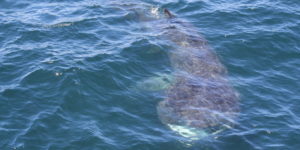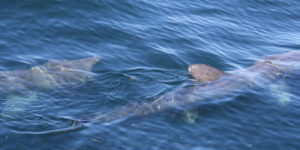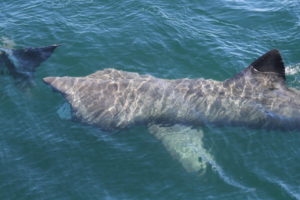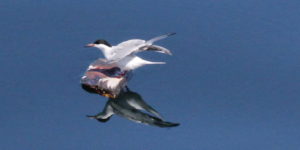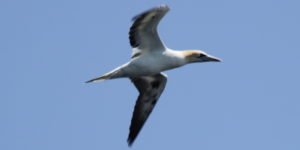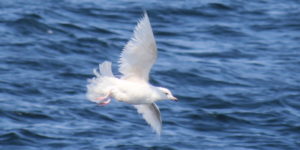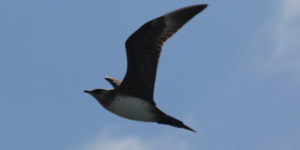Naturalist’s Notebook – June 04, 2016 to June 10, 2016
The morning fog hung high in the air on June 4, almost like a haze over the Dolphin VIII as it travelled toward Peaked Hill. In recent weeks, there have been a lot of Minke whale sightings. Today’s was just phenomenal. Even under the gray haze you could clearly see the shape of the whale as it swam around the boat in circles. The muted light of the sun was still enough to reflect off of the epaulettes on the upper side of its flippers, showing green through the water even without bright sunshine. The passengers were very neatly exposed to the rostrum-first surfacings of this species as the whale rose to port, then on the bow, then to starboard, and lastly on the stern. Then the cycle was repeated, over and over again for more than twelve minutes while the whale never spent more than two minutes or so beneath the water. It just kept swimming around us, clearly curious about the very large object that doesn’t even enter its world as far as it enters the atmosphere when it breathes.
Nancy, aboard the Dolphin X, reports Minkes lunging at the surface and goes on to comment on the huge schools of bass that were rolling over top of schools of sand eels, coming belly up at the surface in their efforts to cash in on the wealth of food at the surface of the water.
She also writes, “Great lunges from Clamp’s 2012 [unnamed] calf, coming up shooting out of [the] water like a bullet, wide open mouth closing quickly. The last lunge was a huge roll, belly up, just like the bass.”
That hazy morning fog settled to the surface beneath bright sunshine for the afternoon, causing one of the mates to suggest that you might be able to see overtop of it from the fly-bridge. From the deck of the boat, visibility was only about 200 feet but, from the fly, you could see quite a good distance. Unfortunately, all you really saw was bright sunshine over the fog bank. This made for a rather unique experience. I have whalewatched in fog on many occasions, but I have never been able to see so clearly above the fog. It made for a nearly other-worldly type of evening.
The weather on June 5 led to the cancelation of most of the day’s whalewatch trips. There were, however, a number of hearty souls that climbed aboard the Dolphin VIII for the afternoon’s event without regard for the wind and the seas and the rain. Mark Gilmore put it this way, “As it turned out, if you like windy rough days, as many of us to, it was perfect. One of those days that remind us what we are really doing out here—looking for giant animals that live far beneath the surface.”
On the surface were rivers of deep blue that snaked their way south and east and west from the southern edge of Stellwagen Bank. These rivers of sand eels turned silver as the shadows from low passing gulls and shearwaters set the little fish in motion, scattering to avoid the aerial danger. As it turned out, though, the greater threat was coming from beneath.
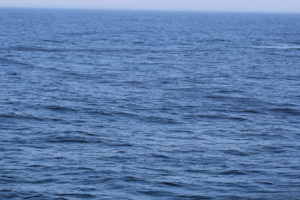
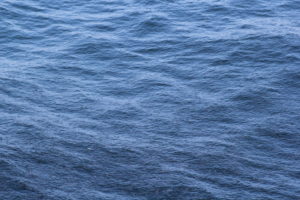
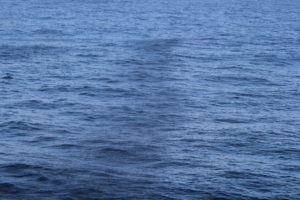
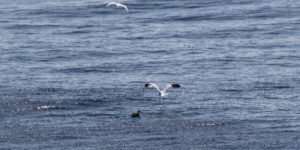
One form this threat took began with fine bubbles, rising around them, encircling them, drawing them closer to each other and pushing them toward the surface as the bubble cloud thickened. Still, the surface promised a chance to escape from the wall and floor of bubbles rising to trap them. That was not to be, though. Before most could reach the top, something loomed large and dark over them, batting at the surface of the water and causing the surface to become a place of noise and confusion. The unnamed 2009 calf of Rapier was kick-feeding in the thick of the river of sand eels. This Humpback’s lunges carried it through the surface with its mouth still open wide, revealling the vertically stacked plates of baleen that, from the outside, hung from its upper jaw like a curtain but, from the inside, was a net of capture for small fishes like these sand eels.
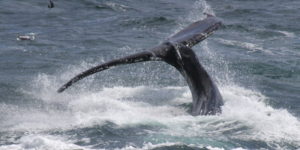
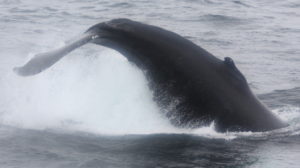
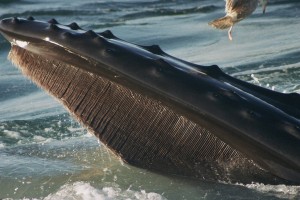
The threat took smaller forms, too. One being this Gray seal and others in the form of Minke whales that relied on the speed of their lunges to maximize the effectiveness of their efforts.
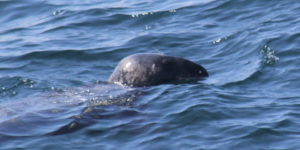
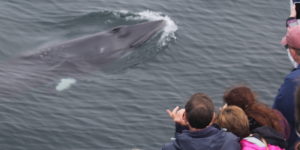
But a much larger, much faster, threat loomed in the depths. Easily a half dozen Finback whales had also been attracted by the huge schools of forage. These were seen lunging through the surface, along the snaking of the rivers, both as single diners and as pairs.
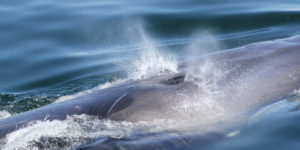
One such pair, would split up and circle around the ball of fish separately and then lunge through it from slightly different angles. One animal would roll at the surface with its mouth agape, collecting the sand eels that had gathered there, while the other would lunge beneath the huge wave and splash created by the lunge of the first. This Finner would surface to the other’s one oclock, nearly porpoising a third of its way out of the water from the force and speed of its charge.
A second pair would lunge together, side by side, rolling through the surfacewith their right sides down. The speed of their passing was incredible, making it very unlikely to get photos of the whole sequence, but still not sufficient enough to prevent any escape.
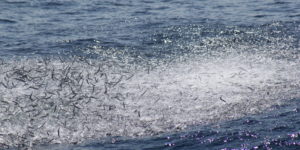
As a naturalist, I talk a lot about the undersides of the flukes of Humpback whales being very important tools as a means to identify them as individuals for study. This usually happens when one of them raises its tail to dive deeper in the water. I will also comment that Finwhales have no need to do this because of their thinner blubber layer so it is an extremely rare thing to see the undersides of a Finner’s tail raised so. And, I have, in the past, remarked that it really doesn’t matter that they don’t fluke up because the undersides of their flukes are pretty much generic. What I saw today makes me question just how accurate that statement is. You see, today, when these two Finners were lunging on their sides and revealling the undersides of their left flukes, I discovered that the two were actually very different. One was much like you would have expected it to be; a dark border surrounding a bright white core. The other had that dark border, but the core it surrounded was gray and hazy. As I thought about the flukes I have seen over the years, I realized that most of them have indeed been like the first Finner’s. And the few exceptions I have seen before today were animals that had their flukes injured or damaged in some way. That’s what I was still musing about when we encountered yet another Finback whale lunging through the rivers of sand eels. This one was lunging left side down and showed that the tip of its right fluke looked distorted, like it wavered in the sun.
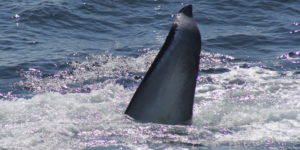
But the fluke of the whale I saw today was not different because of injury or defect, it was a difference in the natural coloring of the whale’s body. For now, I am just reporting what I saw. I remain unsure as to where my processing of this might lead me.
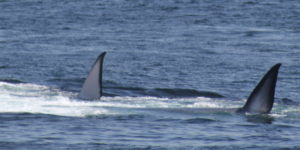
The above sightings of rivers of sand eels and lunging Finners and Minkes began on June 6 and continued for the rest of the week. The detail in the preceeding paragraphs came from the reports of June 6 but similar sightings were reported through June 10.
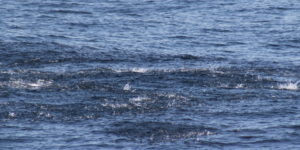
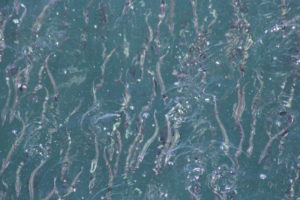
On June 7, the whales feeding on the southern edge of Stellwagen were joined by the Humpback whales, Ventisca and Bayou. These animals appeared to be displaying some cooperative feeding techniques. They would go beneath the surface and bubbles would be blown by one or both of them (most of what occurs beneath the surface is not visible from the deck of a boat). Ventisca would rise to the top and lift her broad tail from the water, bringing it crashing to the surface three or four times, before returning to the depths. The two would surface together through the cloud of confusion and bubbles, mouths overflowing with water and sand eels.
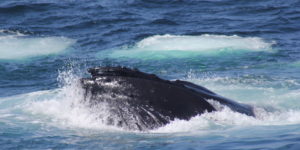
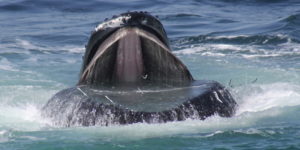
Liz Bradfield also writes, “Oh! Another highlight: a school of mackerel hitting the surface sounded like rounds of applause.”
On June 8, Dennis Minsky adds that, in addion to the feeding Finbacks and Rapier’s ’09 calf, at one point, even the Minkes were lunging at the surface, rolling belly up in the water.
“An ecosystem in action,” is how Dennis Minsky described the activity along the southern end of the bank on June 9. Both he and Carolyn OConnor describe the continued surface feeding behaviors of Minke whales, Finback whales, and Humpback whales. Clouds of gulls (mostly Herring gulls and Greater Black-backed gulls) and shearwaters (mainly Sooty and Great) accompanied the feeding whales, dropping into the water briefly to snatch out their own mouthfuls.
June 10″started out in trepidation, with warnings of high wind and waves, but the further out we went the calmer it got. Finally, south of the triangle, the skies were bright blue, the shoreline was pristine and beautiful, and the clouds were dynamic. A small flock of Common Terns wheeled and dived as one body. And then we saw them: 4 Finners, side-by-side lunging through the sand eels that skittered for their lives in a boiling frenzy- [the Finwhales] on their side, upside down, and in a froth of white water.”
The other report of interest today was not about whales. Liz writes that two basking sharks were eschelon feeding. Basking sharks feed much like Right whales, opening their mouths and swimming forward through the water to allow food rich waters to enter. The waters pass over the gills, where the gills themselves extract the oxygen from the water as the gill rakers collect tiny animals, like copepods. Eschelon feeding is when two or more sharks swim along feeding together. When there are just two, they look like one is almost following the other. When there are more than that, they look like the ragged V-shaped formation of geese in flight.
